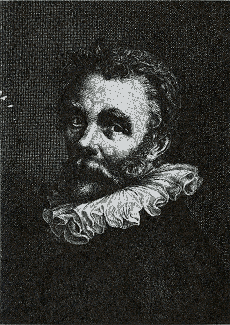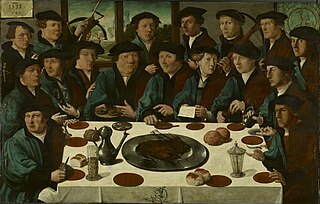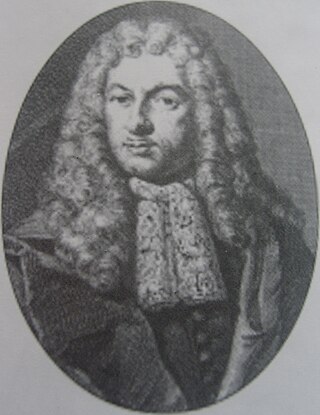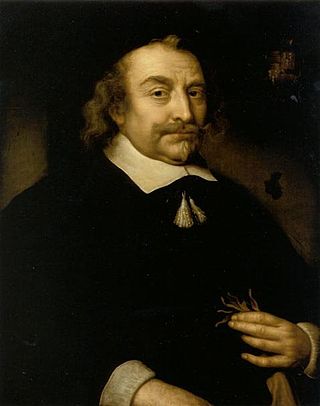
The Rijksmuseum is the national museum of the Netherlands dedicated to Dutch arts and history and is located in Amsterdam. The museum is located at the Museum Square in the borough of Amsterdam South, close to the Van Gogh Museum, the Stedelijk Museum Amsterdam, and the Concertgebouw.

Ludolf Bakhuizen was a German-born Dutch painter, draughtsman, calligrapher and printmaker. He was the leading Dutch painter of maritime subjects after Willem van de Velde the Elder and Younger left for England in 1672. He also painted portraits of his family and circle of friends.

Bartholomeus van der Helst was a Dutch painter. Considered to be one of the leading portrait painters of the Dutch Golden Age, his elegant portraits gained him the patronage of Amsterdam's elite as well as the Stadtholder's circle. Besides portraits, van der Helst painted a few genre pictures as well as some biblical scenes and mythological subjects.

Cornelis Corneliszoon van Haarlem was a Dutch Golden Age painter and draughtsman, one of the leading Northern Mannerist artists in the Netherlands, and an important forerunner of Frans Hals as a portraitist.

Dirck Jacobsz (1496–1567) was a Dutch Renaissance painter. His exact birthplace is unknown, but it was somewhere near Amsterdam.

Schutterij refers to a voluntary city guard or citizen militia in the medieval and early modern Netherlands, intended to protect the town or city from attack and act in case of revolt or fire. Their training grounds were often on open spaces within the city, near the city walls, but, when the weather did not allow, inside a church. They are mostly grouped according to their district and to the weapon that they used: bow, crossbow or gun. Together, its members are called a Schuttersgilde, which could be roughly translated as a "shooter's guild". It is now a title applied to ceremonial shooting clubs and to the country's Olympic rifle team.

Pieter Jacobsz Codde was a Dutch painter of genre works, guardroom scenes and portraits.

Cornelis or Cornelius Ketel was a Dutch Mannerist painter, active in Elizabethan London from 1573 to 1581, and in Amsterdam till his death. Ketel, known essentially as a portrait-painter, was also a poet and orator, and from 1595 a sculptor as well.

Cornelis Anthonisz., Anthonisz. also spelled Anthonissen or Teunissen, was a Dutch painter, engraver, and mapmaker.

Witsen is a patrician family of Amsterdam. Its most notable member was the politician and scholar Nicolaes Witsen, but many other members of the family also held leading roles in trade and politics from the Dutch Golden Age up until the French occupation of the Netherlands in the late 18th century.

Anthonie Palamedesz., also Antonie Palamedesz, birth name Antonius Stevens, was a Dutch portrait and genre painter. He is in particular known for his merry company paintings depicting elegant figures engaged in play, music and conversation as well as guardroom scenes showing soldiers in guardrooms. Like many Dutch painters of his time, he painted portraits and still lifes, including vanitas still lifes. He further painted the staffage in a few views of the interior of churches. He played a major role in the development of genre painting in Delft in the mid 17th century.

The Officers of the St Adrian Militia Company in 1630 refers to the schutterstuk painted by Hendrik Gerritsz Pot for the Cluveniers, St. Adrian, or St. Hadrian civic guard of Haarlem, and today is considered one of the main attractions of the Frans Hals Museum there.

The Banquet of the Officers of the St George Militia Company is an oil-on-canvas painting by the Dutch artist Frans Hals, painted from 1626 - 1627, during the Dutch Golden Age. Today, the piece is considered one of the main attractions of the Frans Hals Museum.

Andries van Hoorn, or van der Horn, was a Dutch mayor of Haarlem, known best today for his portraits by Frans Hals.

The Meagre Company, or The Company of Captain Reinier Reael and Lieutenant Cornelis Michielsz Blaeuw, refers to the only militia group portrait, or schutterstuk, painted by Frans Hals outside of Haarlem. Today the painting is in the collection of the Amsterdam Museum, on loan to the Rijksmuseum, where it is considered one of its main attractions of the Honor Gallery. Hals was unhappy about commuting to Amsterdam to work on the painting and, unlike his previous group portraits, was unable to deliver it on time. The sitters contracted Pieter Codde to finish the work.

The Haarlem schutterij refers to a collective name for the voluntary civic guard of Haarlem, from medieval times up to the Batavian Revolution in 1794, when the guilds of Haarlem were disbanded.

The Kloveniersdoelen was a complex of buildings in Amsterdam which served as headquarters and shooting range for the local schutterij. The companies of kloveniers were armed with an early type of musket known as an arquebus, known in Dutch as a bus, haakbus or klover, hence the name kloveniers.

The Handboogdoelen is a building on the Singel canal in Amsterdam, near Koningsplein square. It dates back to the early 16th century and originally served as headquarters and shooting range of the local schutterij. Most of the current building at Singel 421 dates to the 18th century and is part of the main complex of the Amsterdam University Library. The Doelenzaal hall on the ground floor of the building is used for lectures, meetings, receptions and doctoral dissertations. The building has rijksmonument status.

Cornelis Bicker van Swieten, heer (lord) van Swieten, was an Amsterdam regent of the Dutch Republic during the Golden Age. He traded in sugar, was a governor of the Dutch West India Company and director of the Wisselbank. He was schepen, hoogheemraad of the Hoogheemraadschap van Rijnland and a counsellor of the States of Holland and West Friesland at The Hague.

Banquet of the Amsterdam Civic Guard in Celebration of the Peace of Münster (1648) is a group portrait oil painting by the Dutch painter Bartholomeus van der Helst. It is an example of Dutch Golden Age painting and is considered one of the highlights of the Amsterdam Museum, though it is generally on show in the Rijksmuseum.





























